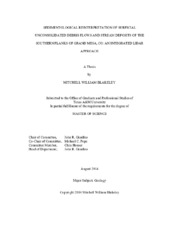| dc.description.abstract | The southern slopes of Grand Mesa Colorado consist of glacio-fluvial sediments deposited when the Pleistocene ice cap draping Grand Mesa melted. Debris flows intermixed with braided and meandering stream deposits, were the focus of this study. This study developed a sedimentological description and interpretation of these deposits and tested the capabilities of terrestrial LiDAR (Light Detection and Ranging) for use in sedimentological studies. This research addressed the origin of the deposits south of Grand Mesa and evaluated the significance of terrestrial LiDAR for examination, description and interpretation of sedimentary facies at outcrop scale.
The main outcrop exposed along highway 65 near Cory Grade, Colorado, was studied along with similar outcrops in the area. Field observations aided in calibrating interpretations from LiDAR scans and GigaPan® panoramic images. Facies were distinguished by grain size, depositional fabric, sedimentary structures and stratal geometries. Eight facies, making up three depositional environments were interpreted; Debris flows from the mesa, glacio-fluvial deposits from drainage of melt water, and fluvial deposits from the paleo Gunnison River.
A stratigraphic column of the Cory Grade outcrop shows changes in depositional environments through time. This measured section aided in creation of facies models illustrating changing depositional environments. The first model illustrates the onset of melt sending large volumes of sediment in braided streams and outwash deposits. These north-south trending deposits are cross-cut by low sinuosity east-west trending abandoned channel and overbank deposits of the paleo Gunnison River.
The second model illustrates that ice cap melt exposed a basalt cap and greater numbers of massive debris flows occurred. The ancestral Gunnison River continued to avulse and abandon channels, and with the increase in water and influx of sediment it migrated south to establish stable channels and banks.
The third model suggests that once the ice cap melted, the lack of sediment from the north restricted river avulsion and small finger mesas were created. Additionally, with the lack of sediment from the mesa, the Gunnison River established a more permanent floodplain, and today flows south of the outcrops. | en |


